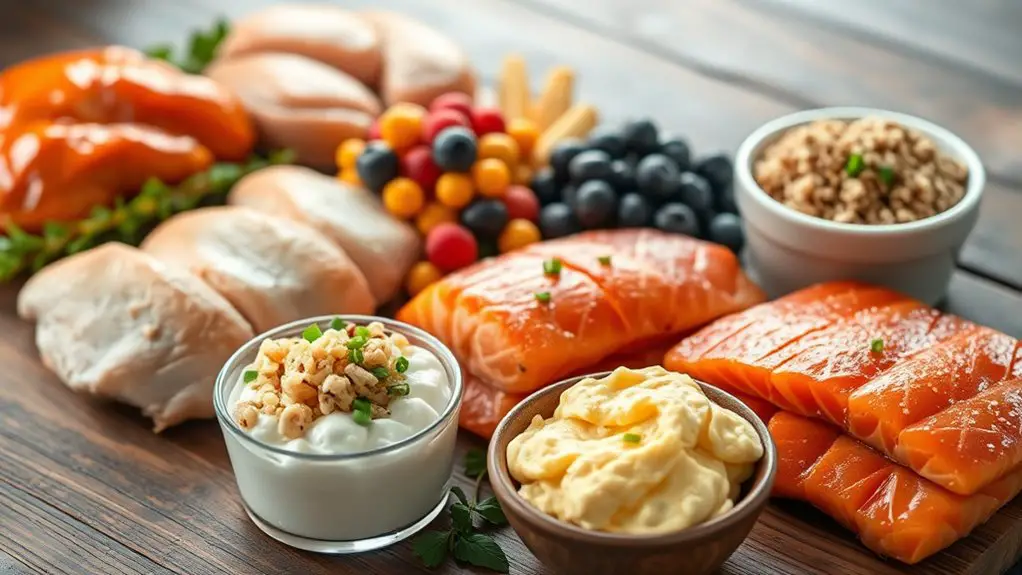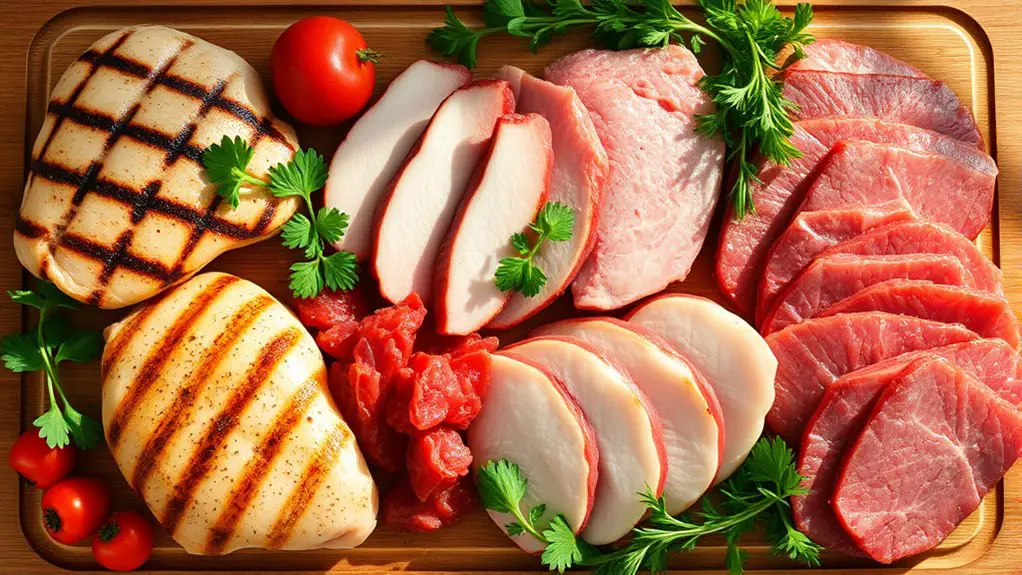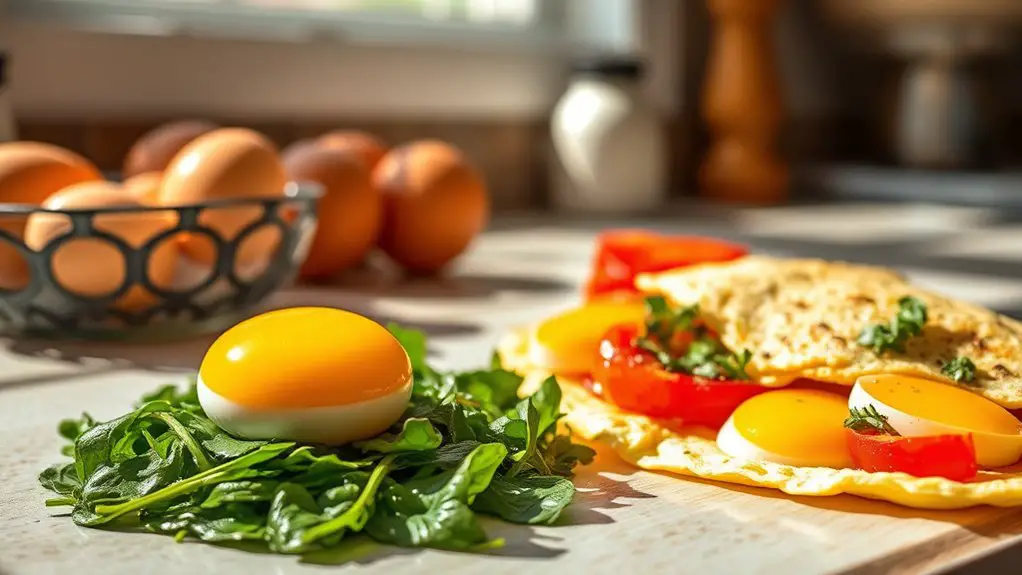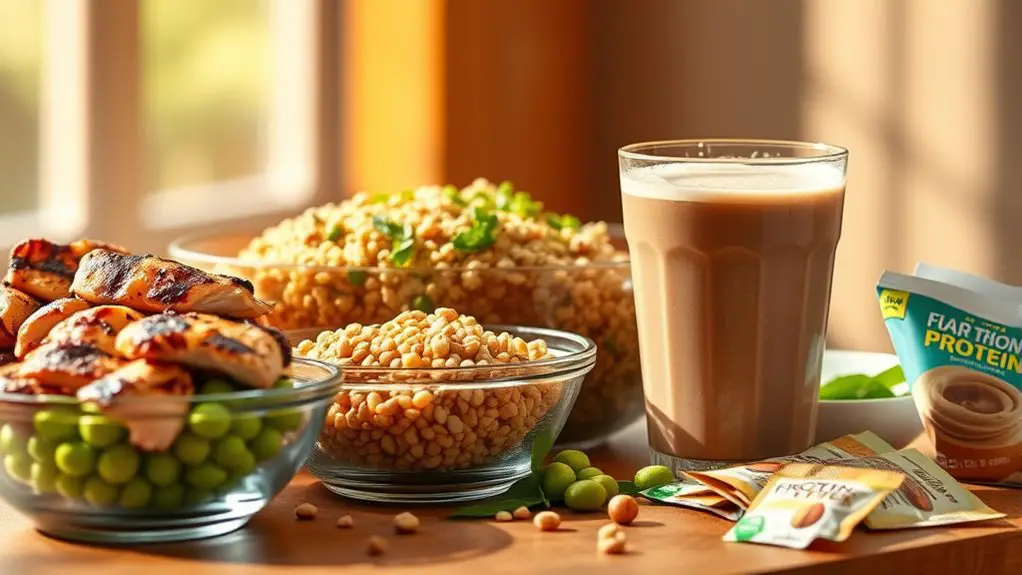Best High-Protein Foods for Gym Enthusiasts

If you’re a gym enthusiast looking for high-protein foods, consider incorporating lean meats like chicken and turkey, which are essential for muscle repair. Dairy products, such as Greek yogurt and cottage cheese, offer creamy protein sources, while eggs are versatile and nutrient-packed. Don’t forget plant-based options like quinoa and lentils, or seafood rich in omega-3s. For quick snacks, turn to nuts and seeds. Keep exploring these options for an even stronger protein boost!
Lean Meats: The Powerhouse of Protein

When it comes to fueling your workouts, lean meats stand out as one of the best sources of protein. Chicken breast, turkey, and lean cuts of beef or pork provide essential amino acids needed for muscle repair and growth. To maximize flavor while keeping it healthy, consider using safe grilling techniques. Always preheat your grill and guarantee your meat reaches the appropriate internal temperature to eliminate any harmful bacteria.
Don’t underestimate the power of marinades, either! They not only enhance the taste but can also help tenderize your meat. Try a mix of olive oil, lemon juice, garlic, and herbs for a fresh flavor. You can also explore soy sauce or yogurt-based marinades for a unique twist. Just remember to marinate in the fridge to keep things safe. By incorporating lean meats into your diet, you’re setting yourself up for successful workouts and recovery.
Dairy Delights: Creamy Sources of Protein
When it comes to boosting your protein intake, dairy products can be a game changer. Greek yogurt packs a punch with its creamy texture and numerous health benefits, while cottage cheese offers incredible versatility for meals and snacks. Plus, don’t underestimate the power of milk as a rich source of protein to fuel your workouts and recovery.
Greek Yogurt Benefits
Although many dairy products can be high in protein, Greek yogurt stands out as a favorite among gym enthusiasts for good reason. It’s packed with protein, making it an excellent option for muscle recovery and growth. The Greek yogurt health benefits extend beyond protein; it’s also rich in probiotics, which support gut health and digestion.
You can easily incorporate Greek yogurt into your diet with simple Greek yogurt recipes, like smoothies, parfaits, or dressings. It’s versatile enough to enjoy sweet or savory, ensuring you always have a nutritious snack on hand. Plus, it’s lower in sugar compared to regular yogurt, making it a safer choice for those watching their sugar intake. Enjoy the creamy goodness while fueling your fitness journey!
Cottage Cheese Versatility
Greek yogurt isn’t the only creamy delight packed with protein; cottage cheese also deserves a spotlight in your diet. This versatile dairy option can easily fit into your meals, providing a great protein boost while being low in fat. You can enjoy cottage cheese recipes for breakfast, lunch, or dinner. Try mixing it with fruits for a revitalizing snack, or incorporate it into smoothies for added creaminess. For savory options, consider cottage cheese toppings like diced tomatoes, cucumbers, or herbs. The possibilities are endless! Plus, it’s a safe choice for most people, making it a reliable addition to your meal prep. Embrace the versatility of cottage cheese, and watch your protein intake soar!
Milk Protein Power
Milk protein power is an essential component of a gym enthusiast’s diet, offering a creamy source of protein that fuels your workouts and aids recovery. By incorporating milk into your nutrition plan, you can enjoy several milk protein benefits, including muscle repair and growth. Milk is rich in essential amino acids, making it an excellent choice for post-exercise recovery.
When considering milk protein sources, options like Greek yogurt, cheese, and whey protein powder are not only delicious but also packed with nutrients. These dairy delights can easily be added to smoothies, snacks, or meals. Whether you’re looking to build muscle or maintain a healthy lifestyle, integrating milk into your routine can guarantee you’re getting the protein you need safely and effectively.
Plant-Based Proteins: Fueling Your Gains
When it comes to fueling your gains, plant-based proteins can be a game changer. From lentils to quinoa, there are plenty of top sources you can incorporate into your diet. Plus, with some clever cooking tips and ideas, you’ll keep your meals exciting while still hitting your protein goals.
Top Plant Proteins
Plant proteins are a powerhouse for gym enthusiasts looking to enhance their performance while embracing a plant-based lifestyle. Incorporating these proteins into your diet can support muscle recovery and overall health. Here are some top plant protein sources to take into account:
| Plant Protein | Protein Content (per 100g) |
|---|---|
| Tofu Options | 8g |
| Lentils | 9g |
| Quinoa (cooked) | 4g |
| Chickpeas | 8g |
Tofu options are versatile and can be used in various dishes, while quinoa recipes provide complete protein with all essential amino acids. With these choices, you’ll fuel your gains safely and effectively on your plant-based journey.
Cooking Tips and Ideas
Cooking with plant-based proteins can be a delicious and fulfilling way to fuel your workouts and boost recovery. By focusing on meal prep and using safe cooking methods, you can maximize the benefits of these nutritious foods. Here are three tips to get you started:
- Batch Cook: Prepare large quantities of lentils, quinoa, or chickpeas ahead of time, so you always have protein-rich options ready to go.
- Experiment with Cooking Methods: Try grilling, roasting, or stir-frying your plant proteins to enhance flavor and texture.
- Mix and Match: Combine different sources, like beans and rice or tofu and vegetables, to create complete protein profiles and keep your meals interesting.
With these tips, you can easily integrate plant-based proteins into your diet!
Eggs: The Versatile Protein Source

Eggs are one of the most versatile protein sources you can include in your diet, offering a perfect blend of essential amino acids that support muscle repair and growth. Not only are they packed with high-quality protein, but they also provide essential nutrients like vitamins D and B12, which are important for overall health. The egg benefits extend beyond just protein; they can help improve your satiety, making them an excellent choice for those managing their weight.
When it comes to preparation, there are countless egg recipes to suit any taste. You can scramble them for a quick breakfast, whip up a frittata loaded with veggies, or make a protein-packed omelet. With their affordability and ease of cooking, eggs are a safe and nutritious choice for gym enthusiasts looking to enhance their performance and recovery. So, why not add some eggs to your meal plan today?
Seafood: Omega-3 and Protein Combo
When it comes to high-protein foods, seafood stands out not only for its protein content but also for its rich supply of omega-3 fatty acids, which are essential for heart and brain health. Plus, many seafood varieties are sourced through sustainable fishing practices, making them a safe choice for both your body and the environment.
Here are three excellent seafood options to ponder:
- Salmon: Packed with protein and omega-3s, it’s a tasty option for any meal.
- Tuna: Low in calories but high in protein, it’s perfect for a quick snack or salad.
- Sardines: Often overlooked, these tiny fish are nutrient-dense and offer a sustainable choice.
Incorporating these seafood varieties into your diet can help you meet your protein needs while benefiting from their heart-healthy fats. Enjoying seafood responsibly supports a sustainable future!
Protein Supplements: Convenient Options

While incorporating whole foods into your diet is important, protein supplements can provide a convenient way to boost your intake, especially for those on the go. There are various protein powder types, including whey, casein, and plant-based options. Each has its unique benefits; for instance, whey digests quickly, making it ideal for post-workout recovery, while casein offers a slow release of amino acids, perfect for nighttime.
When it comes to supplement timing, consuming protein shortly after your workouts can enhance muscle recovery and growth. Just be mindful of your overall diet and make certain that these supplements complement your meals rather than replace them entirely. Always choose high-quality products that have been tested for safety and efficacy, so you can feel confident in your choices. By integrating the right protein supplements into your routine, you can effectively support your fitness goals while maintaining your well-being.
Legumes and Pulses: Nutrient-Dense Choices
In addition to protein supplements, incorporating legumes and pulses into your diet can greatly enhance your protein intake. These nutrient-dense choices not only provide a solid protein boost but also come packed with additional nutritional benefits, including fiber, vitamins, and minerals.
Here are three legumes and pulses you should consider adding to your meals:
- Chickpeas: Great in salads or as hummus, they’re versatile and delicious.
- Lentils: Perfect for soups or stews, they’re quick to cook and rich in nutrients.
- Black beans: Excellent in burritos or tacos, they add a hearty texture.
These options can easily be incorporated into your meal prep, offering endless recipe ideas while helping you meet your fitness goals. By choosing legumes and pulses, you’re not just boosting your protein; you’re also prioritizing your health and well-being.
Nuts and Seeds: Protein-Packed Snacks
Nuts and seeds make for excellent protein-packed snacks that can easily fit into your busy lifestyle. They’re not only convenient but also packed with essential nutrients. Different nut varieties, like almonds, walnuts, and pistachios, offer unique flavors and health benefits. Almonds are great for boosting heart health, while walnuts are known for their brain-boosting omega-3s.
Seeds, such as chia and pumpkin seeds, also provide impressive seed benefits. Chia seeds are rich in fiber and help with digestion, while pumpkin seeds offer a punch of magnesium and antioxidants.
When choosing your snacks, opt for unsalted or lightly salted versions to keep your sodium intake in check. A handful of nuts or a mix of seeds can easily satisfy your hunger and fuel your workouts. Plus, they’re a safe, nutritious option to keep on hand, whether you’re at home or on the go.
Whole Grains: Carbs With a Protein Boost
When it comes to fueling your workouts, whole grains are a fantastic option that complements the protein from nuts and seeds. Not only do they provide essential carbohydrates for energy, but they also come with whole grain benefits, including improved digestion and heart health. Plus, some varieties are protein rich, making them perfect for gym enthusiasts.
Whole grains fuel workouts effectively, offering energy and health benefits while complementing protein from nuts and seeds.
Here are three whole grain options you should consider:
- Quinoa: This pseudo-grain packs about 8 grams of protein per cup and is gluten-free.
- Farro: An ancient grain with a nutty flavor, farro contains around 7 grams of protein per cup cooked.
- Barley: With about 3.5 grams of protein per cup, barley is also rich in fiber, which helps keep you full.
Incorporating these grains into your meals can help you meet your protein needs while enjoying tasty dishes.
Frequently Asked Questions
How Much Protein Do I Need Daily for Muscle Gain?
To effectively support muscle gain, you’ll generally need around 1.6 to 2.2 grams of protein per kilogram of body weight daily. This protein intake helps with muscle recovery and growth after workouts. It’s essential to spread your protein consumption throughout the day for best results. Always consult a healthcare professional or a nutritionist to tailor your intake to your specific needs, ensuring you’re safely meeting your fitness goals.
Are There Vegetarian Sources of Complete Proteins?
Yes, there are vegetarian sources of complete proteins! Curiously, combining different plant-based foods can yield a complete amino acid profile; about 30% of vegetarians don’t get enough protein. Quinoa is a fantastic option, as it contains all nine essential amino acids. Pairing it with legumes enhances its benefits, ensuring you meet your protein needs safely. So, don’t hesitate to explore these combinations to maintain a balanced diet while enjoying delicious meals!
Can I Consume Too Much Protein?
Yes, you can consume too much protein, and it’s important to be cautious. Excessive protein intake might lead to protein toxicity, which can strain your kidneys over time. If you have pre-existing kidney issues, high protein diets could worsen your health. It’s wise to balance your protein sources and guarantee you’re not overdoing it. Always consult a healthcare professional to determine the right amount for your individual needs and maintain kidney health.
What Are the Best Times to Eat Protein?
To maximize your protein intake effectively, focus on post workout timing. Eating protein within 30-60 minutes after exercise helps with muscle recovery and growth. It’s also beneficial to spread your protein meal frequency throughout the day, aiming for balanced meals every few hours. This way, you maintain a steady supply of amino acids for your body. Just remember, moderation is key, and listen to your body’s needs to guarantee safety.
How Do I Combine Proteins for Better Absorption?
To improve protein absorption, you can focus on protein pairing and protein synergy. Combining animal and plant proteins, like eggs with whole grains, can enhance your body’s ability to utilize amino acids. It’s important to guarantee you’re getting a variety of protein sources throughout the day, as this can promote better digestion and absorption. Always consult a nutritionist if you’re unsure about your protein intake to guarantee it’s safe and effective for your needs.





